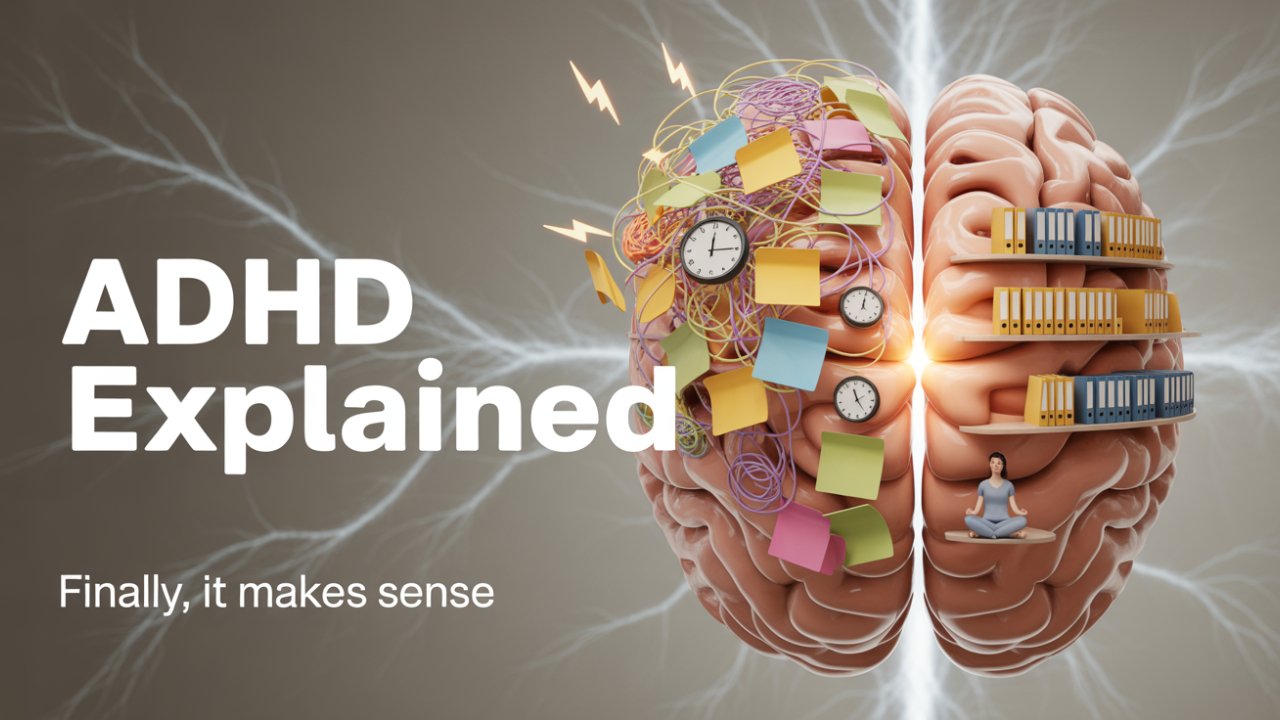Have you ever felt like you’re living life on hard mode? Like you’re playing a video game, but the controls are just slightly out of sync, and it seems like everyone else got a manual you were never given? You lose your keys, not once in a while, but all the time. Your mind drifts during important conversations, even when you’re trying with all your might to focus. And that big project, the one that could change everything, feels completely impossible to even start.
You’ve probably been told to “just try harder,” to “get organized,” or to “stop being lazy.” You’ve probably told yourself those same things a thousand times. But what if it isn’t a lack of effort? What if it’s not a character flaw, a moral failing, or a sign that you just don’t care?
What if your brain is simply wired differently?
This is the reality for millions of people with Attention-Deficit/Hyperactivity Disorder, or ADHD. It’s one of the most common neurodevelopmental conditions on the planet, yet it remains one of the most profoundly misunderstood. This isn’t just about hyperactive kids in a classroom. It’s a lifelong condition that follows people into their careers, their relationships, and their deepest sense of who they are. The constant battle against a brain that works differently can leave you feeling inadequate, frustrated, and completely exhausted.
But understanding is the first step to changing that story. So today, we’re throwing out the confusing medical jargon and harmful stereotypes. We’re going to break down what ADHD truly is, in simple terms, using analogies that finally make sense of the chaos. We’ll explore why the ADHD brain struggles with things neurotypical brains find simple, but also where it can shine with an intensity that looks a lot like a superpower. This isn’t just about defining a disorder; it’s about getting a new blueprint for understanding yourself, or the people you love. It’s about realizing it’s not your fault. And you are not alone.
First things first, we need to talk about the name itself. Attention-Deficit/Hyperactivity Disorder is, frankly, a terrible name. It suggests a deficit, or a lack of attention. But if you have ADHD, or love someone who does, you know that’s not quite right. It’s not a lack of attention, it’s a chronic inability to regulate it.
People with ADHD have plenty of attention. In fact, you could say their brain is paying attention to everything, all at once. The clock ticking on the wall, the tag scratching your shirt, a conversation from across the room, a random memory from ten years ago, your mental to-do list, and the words you’re speaking right now in the ADHD brain, all of these can feel like they have the same volume. The problem isn’t a deficit of attention; it’s a problem with the filter.
To make sense of this, let’s use our first core analogy. Imagine your brain is a massive corporation. The CEO is your Prefrontal Cortex, the part of your brain responsible for “executive functions.” These are the big-picture decisions: planning, organizing, prioritizing tasks, and managing time. A good CEO can look at a hundred things on their desk and instantly know what’s critical, what can wait, and what’s just noise.
Now, every CEO needs an executive assistant. This assistant’s job is to manage the flow of information. They stand at the CEO’s door and decide who gets in. Is this information urgent? Is it relevant? Or is it a distraction? A good assistant is ruthless turning away time-wasters, filing non-urgent thoughts for later, and only letting through what the CEO needs to focus on right now.
In a neurotypical brain, this CEO-assistant team works pretty well. But in the ADHD brain, you have a brilliant, creative, high-energy CEO with an overwhelmed, easily distracted, and hopelessly inefficient assistant.
This is the very heart of Inattentive ADHD.
The assistant in the ADHD brain has a terrible filing system. A random, interesting thought like “do penguins have knees?” feels just as urgent as the deadline that’s an hour away. The car alarm outside gets the same priority as your boss’s instructions for a huge project. Everything gets shouted at the CEO at once. The result is pure mental chaos.
This is why someone with ADHD can seem like they aren’t listening. They are listening, but they’re also listening to ten other things happening inside and outside their head. They’re trying to catch your words as they fly by in a hurricane of other data.
This “inefficient assistant” explains so many of the classic inattentive symptoms.
Losing your keys, wallet, or phone constantly? The assistant didn’t flag the memory of “where I put my keys” as important. It got tossed in the mental junk pile with the lyrics to a song from this morning. You don’t remember where you put them because your brain didn’t register the action as a priority worth storing in an accessible place.
Struggling to finish tasks or follow multi-step instructions? The CEO gets the first instruction, but by the time the second one comes, the assistant has let in five other “urgent” thoughts. The original plan is just lost in the noise. It’s not defiance; it’s a breakdown in the chain of command.
Making “careless” mistakes? It’s not carelessness. It’s the CEO trying to work with a jumbled mess of information. You can proofread a document ten times and still miss a glaring typo because your brain’s filter decided it wasn’t important enough to flag.
And what about procrastination, especially on big, boring tasks? For the ADHD brain, starting a task like that is like asking that overwhelmed CEO to build a skyscraper with no blueprint, while the assistant is shouting random suggestions. The sheer mental energy it takes to force the system to focus on one non-stimulating thing is monumental. It’s physically and mentally draining. The brain’s path of least resistance is to turn to anything that is more interesting and provides an immediate hit of dopamine the neurotransmitter for reward and motivation that is regulated differently in the ADHD brain.
This isn’t a choice. It’s neurology. The system is built to seek out stimulation, not to plod through monotonous work. It’s a system designed for novelty, which makes the mundane duties of everyday life incredibly hard.
Now for the other side of the coin: Hyperactivity and Impulsivity. If the inattentive brain is a company with a bad assistant, the hyperactive-impulsive brain is best described as a Ferrari with bicycle brakes.
Imagine you have the engine of a Formula 1 race car in your head. It’s powerful, fast, and constantly revving, hungry for stimulation. This engine is the hyperactive mind. It generates thoughts, ideas, and physical energy at an incredible rate. It’s a mind that is always “on the go,” as if driven by a motor.
This engine isn’t a bad thing. It can be the source of amazing creativity, relentless energy, and the ability to make connections others miss. It’s a powerful asset.
The problem? This high-performance engine is paired with the braking system of a kid’s bicycle. The brakes representing the brain’s impulse control are weak, unreliable, and simply not built to handle the power of the engine they’re supposed to manage.
This is the core of hyperactivity and impulsivity. It’s not about being intentionally disruptive. It’s about having a profound, biological difficulty with self-regulation.
Let’s break down how this shows up in daily life.
That constant need to fidget, tap your foot, or squirm? That’s the engine idling. It’s humming with so much energy it has to go somewhere. Staying perfectly still is like trying to hold a revving race car at a dead stop with tiny rubber brake pads. It’s physically uncomfortable. The energy builds until it has to escape through small movements. In a kid, this might look like running and climbing at the wrong times. In an adult, it’s often an intense inner restlessness. You might look calm, but inside, your engine is screaming down the track.
Talking excessively or interrupting people? This is a classic sign of weak brakes. A thought forms in the hyper-fast brain, and before the braking system can ask, “Is it my turn to speak?” or “Is this relevant?”, the thought is already out of your mouth. This doesn’t come from a desire to be rude. It’s a lag in the impulse control system. You often realize you shouldn’t have said it the second the words are out.
Acting without thinking or taking big risks? This is impulsivity in its purest form. The race car brain sees an exciting opportunity a shortcut in traffic, an impulse buy and slams the accelerator. The bicycle brakes aren’t strong enough to stop that momentum. The part of the brain that should be weighing long-term consequences gets bypassed for the immediate thrill.
Difficulty waiting your turn? To the race car brain, waiting in line is agonizing. The engine is built for speed. When forced to a standstill, the frustration and restlessness can become overwhelming. It feels like being trapped, and the impulse to just do something becomes almost unbearable.
It’s also important to know that for many adults, especially women, hyperactivity doesn’t look like a child bouncing off the walls. It’s often more subtle. It can be a mind that never stops racing replaying conversations, planning, and jumping from topic to topic. It can look like being a workaholic, always needing to be busy. The engine is still revving at 8,000 RPM; the driver has just learned to keep the car from lurching forward, even if the effort is exhausting.
And of course, many people have Combined Type ADHD. They’re living with both the overwhelmed assistant and the race car with bad brakes. Their inner world is a constant negotiation between chaos and impulse, a whirlwind of distraction punctuated by bursts of uncontrolled action. It’s a profoundly challenging way to move through a world that’s built for quiet, orderly, single-tasking minds.
So what does this all look like in the real world? How do an “inefficient secretary” and a “race car with bad brakes” translate into the painful realities of daily life? This is where you see the true impact of ADHD. It’s not just a few quirks; it’s a persistent pattern that can affect every part of a person’s life.
At School and in Education: You could almost say the modern classroom is a nightmare for the ADHD brain. It demands sustained attention on topics that aren’t always interesting, strict schedules, and sitting still for long periods.
For a student with inattentive symptoms, a 50-minute lecture is a battle. The “inefficient secretary” is letting in every distraction: someone coughing, thoughts of lunch, the memory of a video game. The teacher’s words become background noise. They miss instructions for homework and get accused of not applying themselves or daydreaming too much. The frustration of knowing you’re smart but being unable to make your brain perform on command is a massive blow to self-esteem.
For the student with hyperactive-impulsive symptoms, the classroom is a cage. The “race car engine” needs movement. Being forced to sit still drains the mental resources they need for learning. They might blurt out answers or get in trouble for being the “class clown” because the impulse is just too strong to contain. They aren’t bad kids; they are kids whose regulatory systems are still developing.
In the Workplace: These challenges don’t just vanish after graduation. At work, an adult with ADHD might look at a large project and experience “task paralysis.” The “CEO” is so overwhelmed by the sheer number of steps and the secretary’s inability to sort them out that the whole system just shuts down. It looks like procrastination, but it’s actually executive dysfunction. They might miss deadlines not because they don’t care, but because of “time blindness” a poor internal sense of time where an hour and a week can feel exactly the same.
The “race car with bicycle brakes” also causes trouble at work. Impulsively quitting a job out of boredom, speaking out of turn in a meeting, or struggling with monotonous paperwork can lead to a history of poor performance reviews and job-hopping. They might be brilliant in a crisis, but fall apart during the routine, day-to-day grind.
In Relationships (Romantic, Family, and Friendships): Perhaps the most painful impact of ADHD is on relationships. The “inefficient secretary” can make you seem like a neglectful partner. Forgetting a birthday isn’t a sign you don’t care; it’s a sign your brain didn’t flag that data as high-priority. Zoning out during an important conversation can be deeply hurtful. Your partner feels unheard, while you feel guilty because you were trying to focus, but your brain just walked away without permission.
The “bicycle brakes” also cause damage. Impulsivity can lead to saying hurtful things in an argument that you instantly regret. It can lead to financial stress from impulse spending. And emotional dysregulation, a core part of ADHD for many, can mean your moods go from 0 to 100 in an instant, leaving loved ones feeling like they have to walk on eggshells.
This cycle of misunderstanding is exhausting. The person with ADHD feels constantly criticized. Their family feels ignored and hurt. Without understanding that these behaviors are symptoms, not choices, resentment can destroy even the strongest bonds.
The Internal Experience: The Toll on Self-Esteem: Beyond all the external consequences, there is the internal reality of living with undiagnosed or poorly managed ADHD. It is a life lived with a deep, pervasive sense of shame.
From a young age, you’re bombarded with messages: You’re lazy. You’re messy. You’re too much. You’re unreliable. After years of this, you internalize it. That voice becomes the soundtrack to your life. You live with chronic stress, always waiting for the other shoe to drop. What did I forget this time? Who did I offend? What deadline did I miss? This often leads to co-occurring anxiety and depression. You feel like you’re constantly failing to meet your own potential, and you don’t know why.
This is the hidden cost of ADHD. It’s not just about lost keys. It’s about feeling like there is something fundamentally wrong with you, when you’ve really just been trying to operate a unique piece of machinery without the right manual.
So far, this might sound pretty bleak. And the challenges are real. But focusing only on the struggles is missing half the story. The same wiring that causes these problems can also be the source of incredible strengths. ADHD isn’t a broken version of a “normal” brain. It’s a different operating system, with its own unique set of features.
Let’s go back to our analogies.
That “inefficient secretary” who lets all the information flood the CEO’s office? This can lead to extraordinary creativity. Because the filter is weaker, the ADHD brain is always making connections between seemingly unrelated things. It thinks outside the box because it doesn’t really see the box in the first place. This is why so many entrepreneurs, artists, and innovators have ADHD. Their minds are a constant storm of ideas.
And the race car brain? While the “bicycle brakes” cause impulsivity, the “Ferrari engine” provides a boundless source of energy and passion. When someone with ADHD finds something that genuinely fascinates them, they don’t just focus they hyperfocus.
Hyperfocus is the ADHD superpower. It’s the flip side of distractibility. During hyperfocus, that “inefficient secretary” becomes a laser-focused bodyguard, and the “race car engine” is unleashed on a single track. The rest of the world melts away. They can work on a passion project for 12 hours straight without noticing time, hunger, or thirst. In this state, their productivity can be astonishing. The race car is finally on an open track, performing exactly as it was built to.
This same engine provides incredible resilience. People with ADHD have been falling down and picking themselves back up their entire lives. They are natural troubleshooters because the “standard” way has never worked for them. This makes them fantastic in a crisis. When everyone else is panicking, the ADHD brain, which is used to chaos, can become surprisingly calm and clear. The high-stakes environment provides the exact stimulation the brain craves.
That impulsivity, when harnessed, becomes spontaneity and courage. People with ADHD are often more willing to take risks, try new things, and leap into adventure. They are less held back by the fear of failure that can paralyze others.
And finally, many people with ADHD have a deep well of empathy. Having spent their lives feeling misunderstood, they often develop a powerful sensitivity to the feelings of others, especially fellow underdogs.
Recognizing these strengths isn’t about ignoring the challenges. It’s about creating a balanced, accurate picture. The ADHD brain is a package deal. The distractibility is tied to creativity. The hyperactivity is tied to energy. The impulsivity is tied to courage. You can’t have one without the other. The goal of managing ADHD isn’t to crush these traits into a neurotypical mold. It’s about learning to work with the brain’s natural wiring to strengthen the brakes without killing the engine, and to give the secretary a better filing system.
If what we’ve talked about today is hitting home, you might be feeling a lot of things: relief, sadness for years of struggle, maybe some worry about what’s next. The most important thing to know is that while understanding is the first step, it doesn’t have to be the last. There is a path forward, built on professional guidance, personal strategies, and self-compassion.
It all starts with a proper diagnosis. ADHD is a real, biological condition. It’s not something you should diagnose from a social media video. If you suspect you have ADHD, seeking an evaluation from a qualified professional like a psychiatrist or psychologist is the critical first step. They can rule out other conditions that can look like ADHD and confirm a diagnosis.
Once a diagnosis is made, treatment usually stands on three pillars:
Medication: For many, medication is a life-changing tool. But it’s often misunderstood. ADHD medications don’t “cure” ADHD or change your personality. They help correct the underlying neurochemical imbalances. Think of it as upgrading the systems in our analogies. Medication can give the “race car” better brakes, allowing you more control without getting rid of the powerful engine. It can give the “secretary” a better computer, helping them filter distractions and allowing the “CEO” to finally focus. Finding the right medication and dose is a process done with a doctor, but it can provide the foundation for all other strategies.
Therapy and Coaching: Medication can help the brain become more receptive to change, but it doesn’t teach you skills you never developed. That’s where therapy and coaching come in. Cognitive Behavioral Therapy (CBT), adapted for ADHD, is highly effective. It helps you identify and reframe the negative thought patterns that have built up over years. ADHD Coaching is more hands-on. A coach helps you build practical, real-world systems that work with your brain, not against it helping with routines, planners, and accountability.
Lifestyle and Support Strategies: This is about building a life that supports your brain.
Structure and Routine: The ADHD brain loves external structure. Consistent routines for waking up, work, and exercise reduce the mental energy spent on making decisions.
Exercise: Physical activity is one of the best non-medical tools for ADHD. It boosts the very same neurotransmitters that medication targets, improving focus and mood.
Sleep: Poor sleep makes ADHD symptoms much worse. Prioritizing good sleep is essential.
Support Systems: Connecting with other people who get it can be incredibly validating. Finding support groups or online communities can fight the isolation and shame.
The path forward isn’t about “fixing” a broken brain. It’s about learning to be the expert pilot of your own unique, high-performance mind. It’s about understanding its quirks, harnessing its strengths, and building the support systems that allow you to navigate the world with more confidence and less friction.
We’ve seen the chaotic office of the inattentive brain and ridden in the super-charged car of the hyperactive mind. We’ve seen how this wiring can create real challenges at school, at work, and in our most important relationships. And we’ve felt the weight of shame that comes from living life on hard mode.
But we’ve also seen the other side. The brilliant creativity born from a mind that sees a thousand connections. The incredible energy that fuels hyperfocus and drives innovation. The resilience forged from a lifetime of navigating a world not built for you.
Attention-Deficit/Hyperactivity Disorder is not a personal failure. It is not a lack of willpower. It is not an excuse. It is a neurological difference. A different way of being, of thinking, of experiencing the world. And while it brings struggles, it also brings a unique set of gifts.
The most powerful thing you can do, for yourself or for someone you love, is to trade judgment for curiosity and frustration for compassion. The journey of managing ADHD is a marathon, not a sprint. It’s about unlearning a lifetime of negative self-talk and building a new foundation of understanding. It’s about finally getting the instruction manual for your brain and learning, maybe for the first time, how to make it work for you, not against you.
Your brain isn’t broken. It’s just different. And in that difference lies its power.
If this explanation helped you understand yourself or someone you know a little better, please share this video. You never know who it might help finally find the answers they’ve been searching for. For more deep dives into the strategies, science, and stories of living with ADHD, make sure to subscribe and click the bell so you don’t miss our next video. Thank you for watching.





